Early Triassic Episode of the Kresty Volcano–Plutonic Complex Formation in the Maymecha-Kotuy Alkaline Province, Polar Siberia: Geochemistry, Petrology and Uranium–Lead Geochronology
Abstract
1. Introduction
2. Geological Setting
2.1. Geological Setting of the Maymecha-Kotuy Alkaline Province
2.2. The Internal Structure of the Kresty Volcano–Plutonic Complex
3. Materials and Methods
4. Results and Discussion
4.1. Petrography of Studied Rocks
4.2. Chemistry Composition of Rock-Forming and Ore Minerals
4.3. Geochemistry
4.4. Age Characteristics of the Kresty Volcano–Plutonic complex and Its Correlation in Polar Siberia
4.5. Conditions for the Formation of Intrusions
5. Conclusions
Supplementary Materials
Author Contributions
Funding
Data Availability Statement
Acknowledgments
Conflicts of Interest
References
- Kamo, S.L.; Czamanske, G.K.; Amelin, Y.; Fedorenko, V.A.; Davis, D.W.; Trofimov, V.R. Rapid eruption of Siberian food-volcanic rocks and evidence for coincidence with the Permian-Triassic boundary and mass extinction at 251 Ma. Earth Planet. Sci. Lett. 2003, 214, 75–91. [Google Scholar] [CrossRef]
- Ernst, R.E. Large Igneous Provinces; Cambridge University Press: Cambridge, UK, 2014; pp. 1–667. [Google Scholar]
- Surkov, V.S.; Zhero, O.G. Foundation and Development of the Platform Cover of the West Siberian Plate; Subsoil: Moscow, Russia, 1981; pp. 1–143. (In Russian) [Google Scholar]
- Grinev, O.M. Rift Systems of SIBERIA: Methodology of Study, Morphotectonics, Minerageny; Tomsk STT: Tomsk, Russia, 2007; pp. 1–434. (In Russian) [Google Scholar]
- Fedoseev, G.S.; Vorontsov, A.A.; Orekhov, A.A. Fossil travertines and quasi-travertine in the Minusa basin (West Siberia): Structure, composition, and comparative analysis. Russ. Geol. Geophys. 2017, 58, 922–934. [Google Scholar] [CrossRef]
- Vrublevskii, V.V.; Gertner, I.F.; Guti’errez-Alonso, G.; Hofmann, M.; Grinev, O.M.; Mustafaev, A.A. Multiple intrusion stages and mantle sources of the Paleozoic Kuznetsk Alatau alkaline province, Southern Siberia: Geochemistry and Permian U–Pb, Sm–Nd ages in the Goryachegorsk ijolite–foyaite intrusion. Int. Geol. Rev. 2021, 63, 2215–2231. [Google Scholar] [CrossRef]
- Arndt, N.; Lehnert, K.; Vasil’ev, Y. Meimechites: Highly magnesian lithosphere-contaminated alkaline magmas from deep subcontinental mantle. Lithos 1995, 34, 41–59. [Google Scholar] [CrossRef]
- Arndt, N.; Chauvel, C.; Czamanske, G.; Fedorenko, V. Two mantle sources, two plumbing systems: Tholeiitic and alkaline magmatism of the Maymecha River basin, Siberian flood volcanic province. Contrib. Mineral. Petrol. 1998, 133, 297–313. [Google Scholar] [CrossRef]
- Hawkesworth, C.J.; Lightfoot, P.C.; Fedorenko, V.A.; Blake, S.; Naldrett, A.J.; Doherty, W.; Gorbachev, N.S. Magma differentiation and mineralisation in the Siberian continental flood basalts. Lithos 1995, 34, 61–88. [Google Scholar] [CrossRef]
- Malitch, K.N.; Belousova, E.A.; Griffin, W.L.; Martin, L.; Badanina, I.Y.; Sluzhenikin, S.F. Oxygen-Hafnium-Neodymium Isotope Constraints on the Origin of the Talnakh Ultramafic-Mafic Intrusion (Norilsk Province, Russia). Econ. Geol. 2020, 115, 1195–1212. [Google Scholar] [CrossRef]
- Marfin, A.E.; Ivanov, A.I.; Kamenetsky, V.S.; Abersteiner, A.; Yakich, T.Y.; Dudkin, T.V. Contact Metamorphic and Metasomatic Processes at the Kharaelakh Intrusion, Oktyabrsk Deposit, Norilsk-Talnakh Ore District: Application of LA-ICP-MS Dating of Perovskite, Apatite, Garnet, and Titanite. Econ. Geol. 2020, 115, 1213–1226. [Google Scholar] [CrossRef]
- Sharma, M.; Basu, A.R.; Nesterenko, G.V. Temporal Sr-, Nd- and Pb-isotopic variations in the Siberian flood basalts: Implications for the plume-source characteristics. Earth Planet. Sci. Lett. 1992, 113, 365–381. [Google Scholar] [CrossRef]
- Gertner, I.F.; Vrublevskii, V.V.; Sazonov, A.M.; Krasnova, T.S.; Kolmakov, Y.V.; Zvyagina, E.A.; Tishin, P.A.; Voitenko, D.N. Isotope composition and magmatic sources of the Kresty volcano-pluton, Polar Siberia. Dokl. Earth Sci. 2009, 427, 1–7. [Google Scholar] [CrossRef]
- Egorov, L.S. Ijolite-Carbonatite Plutonism; Nedra: Leningrad, Russia, 1991; pp. 1–260. (In Russian) [Google Scholar]
- Chudinova, T.M. Gravimetric Map of the Krasnoyarsk Territory and Adjacent Areas on a Scale of 1:1,500,000; Gravimetric Expedition: Krasnoyarsk, Russia, 1993. (In Russian) [Google Scholar]
- Sazonov, A.M.; Zvyagina, E.A.; Leontyev, S.I.; Gertner, I.F.; Krasnova, T.S.; Kolmakov, Y.V.; Panina, L.I.; Chernyshov, A.I.; Makeyev, S. Platinum-Bearing Alkaline-Ultramafic Intrusions of Polar Siberia; CNTI Publishing House: Tomsk, Russia, 2001; pp. 1–510. (In Russian) [Google Scholar]
- Burgess, S.D.; Bowring, S.A. High-precision geochronology confirms voluminous magmatism before, during, and after Earth’s most severe extinction. Sci. Adv. 2015, 1, e1500470. [Google Scholar] [CrossRef] [PubMed]
- State Geological map of the Russian Federation. Scale 1:1,000,000 (Third Generation); Norilsk series. Sheet R-47—Heta; Lipenkov, G.V., Mashchak, M.S., Kirichenko, V.T., Naumov, M.V., et al., Eds.; Explanatory note; VSEGEI Cartographic Factory: St. Petersburg, Russia, 2018; 464p. (In Russian) [Google Scholar]
- Karmanova, N.G.; Karmanov, N.S. Universal XRF Silicate Analysis of Rocks Using the ARL-9900XP Spectrometer. In All-Russian Conference on X-ray Spectral Analysis No. 7; IGM SB RAS: Novosibirsk, Russia, 2011; pp. 1–126. (In Russian) [Google Scholar]
- Anoshkina, Y.V.; Asochakova, E.M.; Bukharova, O.V.; Tishin, P.A. Improvement of schemes for chemical sample preparation of carbonaceous rocks with subsequent analysis of high-charge elements by inductively coupled plasma mass spectrometry. Bull. TSU 2012, 359, 178–181. (In Russian) [Google Scholar]
- Williams, J.S. U-Th-Pb geochronology by ion microprobe: Application of microanalytical techniques to understanding mineralizing processes. Rev. Econ. Geol. 1998, 7, 1–35. [Google Scholar]
- Ludwig, K.R. User’s Manual for Isoplot/Ex, Version 2.10. In A Geochronological Toolkit for Microsoft Excel; Berkley Geochronology Center Special Publication: Berkeley, CA, USA, 1999; Volume 1, pp. 1–46. [Google Scholar]
- Black, L.; Kamo, S.; Allen, C.; Davis, D.; Aleinikoff, J.; Valley, J.; Mundil, R.; Campbell, I.; Korsch, R.; Williams, I.; et al. Improved 206Pb/238U microprobe geochronology by the monitoring of a trace-element-related matrix effect; SHRIMP, ID–TIMS, ELA–ICP–MS and oxygen isotope documentation for a series of zircon standards. Chem. Geol. 2003, 205, 115–140. [Google Scholar] [CrossRef]
- Ireland, T.R.; Compston, W.; Williams, I.S.; Wendt, I. U-Th-Pb systematics of individual perovskite grains from the Allende and Murchison carbonaceous chondrites. Earth Planet. Sci. Lett. 1990, 101, 379–387. [Google Scholar] [CrossRef]
- Whitney, D.L.; Evans, B.W. Abbreviations for names of rock-forming minerals. Am. Mineral 2009, 95, 185–187. [Google Scholar] [CrossRef]
- Sazonov, A.M.; Romanovsky, A.E.; Gertner, I.F.; Zvyagina, E.A.; Krasnova, T.S.; Grinev, O.M.; Silyanov, S.A.; Kolmakov, Y.V. Genesis of Precious Metal Mineralization in Intrusions of Ultramafic, Alkaline Rocks and Carbonatites in the North of the Siberian Platform. Minerals 2021, 11, 354. [Google Scholar] [CrossRef]
- Mustafaev, A.A.; Gertner, I.F.; Ernst, R.E.; Serov, P.A.; Kolmakov, Y.V. The Paleozoic-Aged University Foidolite-Gabbro Pluton of the Northeastern Part of the Kuznetsk Alatau Ridge, Siberia: Geochemical Characterization, Geochronology, Petrography and Geophysical Indication of Potential High-Grade Nepheline Ore. Minerals 2020, 10, 1128. [Google Scholar] [CrossRef]
- Mustafaev, A.A.; Ernst, R.E.; Gertner, I.F.; Semiryakov, A.S.; Bilali, H.E.L. Mafic dikes of the Mariinsky Taiga Alkaline Province, Kuznetsk Alatau terrane, southwestern Siberia: Intraplate alkaline magmatism in the Central Asian Orogenic Belt. Lithos 2022, 426–427, 106799. [Google Scholar] [CrossRef]
- Middlemost, E.A.K. Naming materials in the magma/igneous rock system. Earth-Sci. Rev. 1994, 37, 215–244. [Google Scholar] [CrossRef]
- Pearce, J.A. A user’s guide to basalt discrimination diagrams. Geol. Assoc. Can. Short Course Notes 1996, 12, 79–113. [Google Scholar] [CrossRef]
- Irvin, T.N.; Baragar, W.R.A. A guide to the chemical classification of the common volcanic rocks. Can. J. Earth Sci. 1971, 8, 523. [Google Scholar] [CrossRef]
- Gűndűz, M.; Asan, K. PetroGram: An excel-based petrology program for modeling of magmatic processes. Geosci. Front. 2021, 12, 81–92. [Google Scholar] [CrossRef]
- Sun, S.; McDonough, W.F. Chemical and Isotopic Systematics of Oceanic Basalts: Implications for mantle Composition and Processes. In Magmatism in the Ocean Basins; Saunders, A.D., Norry, M.J., Eds.; Geological Society: London, UK, 1989; Volume 42, pp. 313–345. [Google Scholar]
- Basu, A.R.; Poreda, R.J.; Teichmann, F.; Vasiliev, Y.R.; Sobolev, N.V.; Turin, B.D. High-3He plume origin and temporal-spatial evolution of the Siberian flood basalts. Science 1995, 269, 822–825. [Google Scholar] [CrossRef] [PubMed]
- Kogarko, L.N.; Zartman, R.E. New data on the age of the Guli intrusion and implications for the relationships between alkaline magmatism in the Maymecha-Kotuy province and the Siberian superplume: U-Th-Pb isotopic systematics. Geochem. Int. 2011, 49, 439–448. [Google Scholar] [CrossRef]
- Malich, K.N.; Khiller, V.V.; Badanina, I.Y.; Belousova, E.A. Results of dating of thorianite and baddeleyite from carbonatites of the Guli massif, Russia. Dokl. Earth Sci. 2015, 464, 1029–1032. [Google Scholar] [CrossRef]
- Malich, K.N. Complex Platinum-Metal Deposits of Polar Siberia: Composition, Sources of Matter and Conditions of Education. Ph.D. thesis, V.S. Sobolev Institute of Geology and Mineralogy of the Siberian Branch of the Russian Academy of Sciences, Novosibirsk, Russia, 2022; pp. 1–50. (In Russian). [Google Scholar]
- Reichow, M.K.; Pringle, M.S.; Al’Mukhamedov, A.I.; Allen, M.B.; Andreichev, V.L.; Buslov, M.M.; Davies, C.E.; Fedoseev, G.S.; Fitton, J.G.; Inger, S.; et al. The timing and extent of the eruption of the Siberian Traps large igneous province: Implications for the end-Permian environmental crisis. Earth Planet. Sci. Lett. 2009, 277, 9–20. [Google Scholar] [CrossRef]
- Wang, T.; Tong, Y.; Huang, H.; Zhang, H.; Guo, L.; Li, Z.; Wang, X.; Eglington, B.; Li, S.; Zhang, J.; et al. Granitic record of the assembly of the Asian continent. Earth-Sci. Rev. 2023, 237, 104298. [Google Scholar] [CrossRef]
- Malitch, K.N.; Badanina, I.Y.; Kostoyanov, A.I. Initial Os-isotopic composition of Os-Ir-Ru alloys from ultramafic massifs of the Polar Siberia. Dokl. Earth Sci. 2011, 440, 1343–1348. [Google Scholar] [CrossRef]
- Borisova, A.Y.; Bindeman, I.N.; Toplis, M.J.; Zagrtdenov, N.R.; Guignard, J.; Safonov, O.G.; Bychkov, A.Y.; Shcheka, S.; Melnik, O.E.; Marchelli, M.; et al. Zircon survival in shallow asthenosphere and deep lithosphere. American Mineralogist 2020, 105, 1662–1671. [Google Scholar] [CrossRef]
- Dalrymple, G.B.; Czamanske, G.K.; Fedorenko, V.A.; Simonov, O.N.; Lanphere, M.A.; Likhachev, A.P. A reconnaissance Ar40/Ar39 geochronological study of ore-bearing and related rocks, Siberian Russia. Geochim. Cosmochim. Acta 1995, 59, 2071–2083. [Google Scholar] [CrossRef]
- Gradstein, F.M.; Ogg, J.G.; Schmitz, M.D.; Ogg, G.M. The Geologic Time Scale 2020; Elsevier: Amsterdam, The Netherlands, 2020; pp. 1–1390. Available online: https://www.elsevier.com/books/geologic-time-scale-2020/gradstein/978-0-12-824360-2 (accessed on 30 October 2020).
- Stoppa, F.; Sharygin, V.V. Melilitolite intrusion and pelite digestion by high temperature kamafugitic magma at Colle Fabbri, Spoleto, Italy. Lithos 2009, 112, 306–320. [Google Scholar] [CrossRef]
- Pearce, J.; Ernst, R.E.; Peate, D.W.; Rogers, C. LIP printing: Use of immobile element proxies to characterize Large Igneous Provinces in the geologic record. Lithos 2021, 392–393, 106068. [Google Scholar] [CrossRef]
- Cocks, L.R.M.; Torsvik, T.H. Siberia, the wandering northern terrane, and its changing geography through the Palaeozoic. Earth-Sci. Rev. 2007, 82, 29–74. [Google Scholar] [CrossRef]
- Plank, T.; Langmuir, C.H. The chemical composition of subducting sediment and its consequences for the crust and mantle. Chem. Geol. 1998, 145, 325–394. [Google Scholar] [CrossRef]
- Kogarko, L.N.; Henderson, M.; Foland, K. The Guli Ultrabasic Alkaline Massif in Polar Siberia: Evolution and Isotope Sources. Dokl. Akad. Nauk 1999, 364, 88–90. (In Russian) [Google Scholar]
- Vladykin, N.V.; Morikio, T.; Miyazaki, T. Problems of Sources of Deep Magmatism and Plumes; Publishing house of the Institute of Geography SB RAS: Petropavlosk-Kamchatsky–Irkutsk, Russia, 2005; pp. 19–37. [Google Scholar]
- Zindler, A.; Hart, S.R. Chemical geodynamics. Annu. Rev. Earth Planet. Sci. 1986, 14, 493–571. [Google Scholar] [CrossRef]
- Vorontsov, A.; Yarmolyuk, V.; Dril, S.; Ernst, R.; Perfilova, O.; Grinev, O.; Komaritsyna, T. Magmatism of the Devonian Altai-Sayan Rift System: Geological and geochemical evidence for diverse plume-lithosphere interactions. Gondwana Res. 2021, 89, 193–219. [Google Scholar] [CrossRef]
- Vorontsov, A.A.; Kovalenko, D.V.; Yarmolyuk, V.V.; Nikiforov, A.V.; Perfilova, O.Y. Geological and isotope-geochemical indicators of plume-lithospheric interactions in the Southwestern frame of the Siberian Craton: Data synthesis for Early Devonian magmatic associations of the Altai-Sayan rift system. Geol. Geophys. 2023, in press. (In Russian) [CrossRef]
- Panina, L.I.; Sazonov, A.M.; Usol’tseva, L.M. Melilite and melilite-containing rocks of the Kresty intrusion (Polar Siberia) and their genesis. Russ. Geol. Geophys. 2001, 42, 1314–1332. (In Russian) [Google Scholar]
- Panina, L.I.; Usoltseva, L.M. Alkaline-ultrabasic mantle-derived magmas, their sources, and crystallization features: Data of melt inclusion studies. Lithos 2008, 103, 431–444. [Google Scholar] [CrossRef]

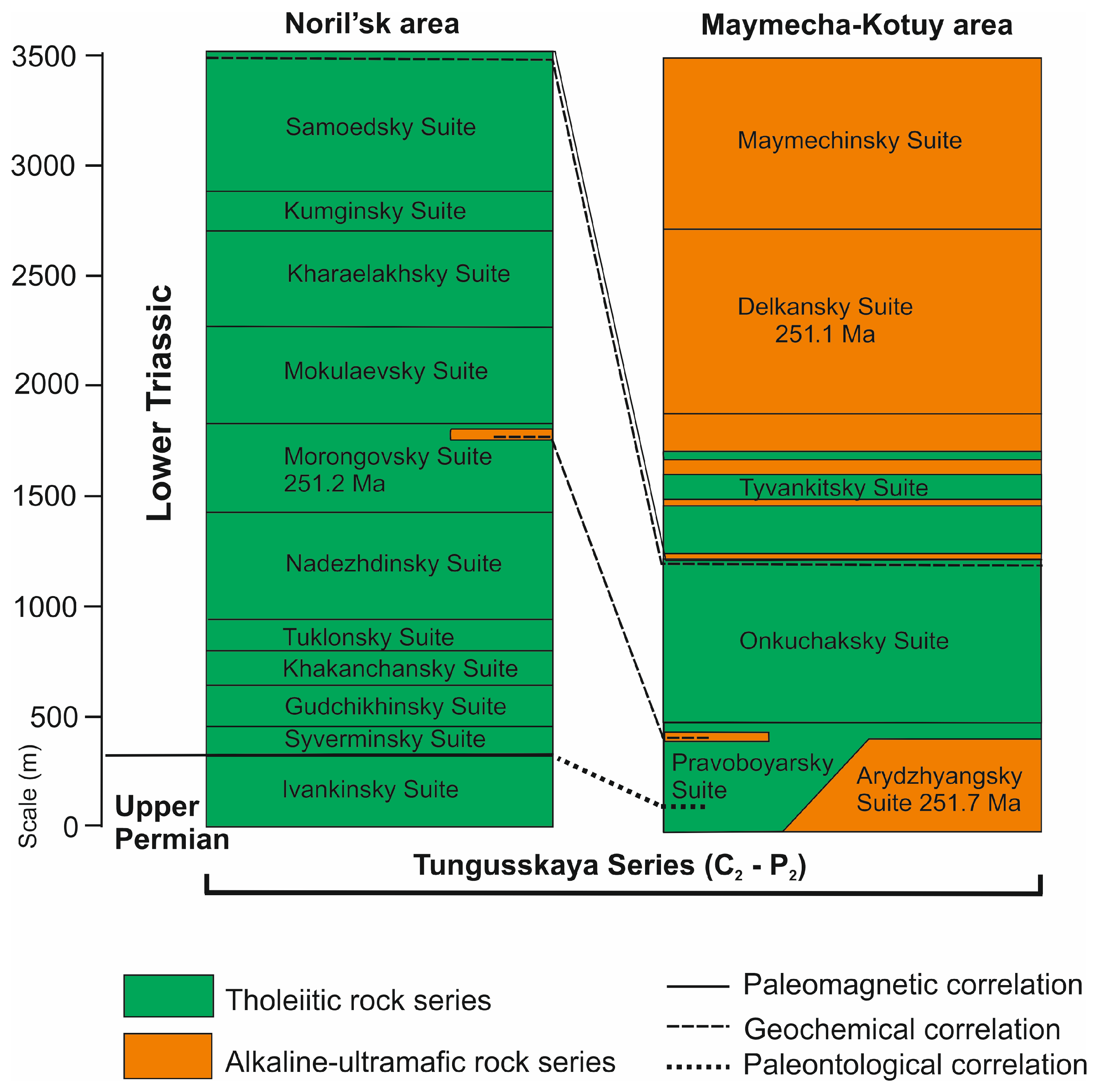

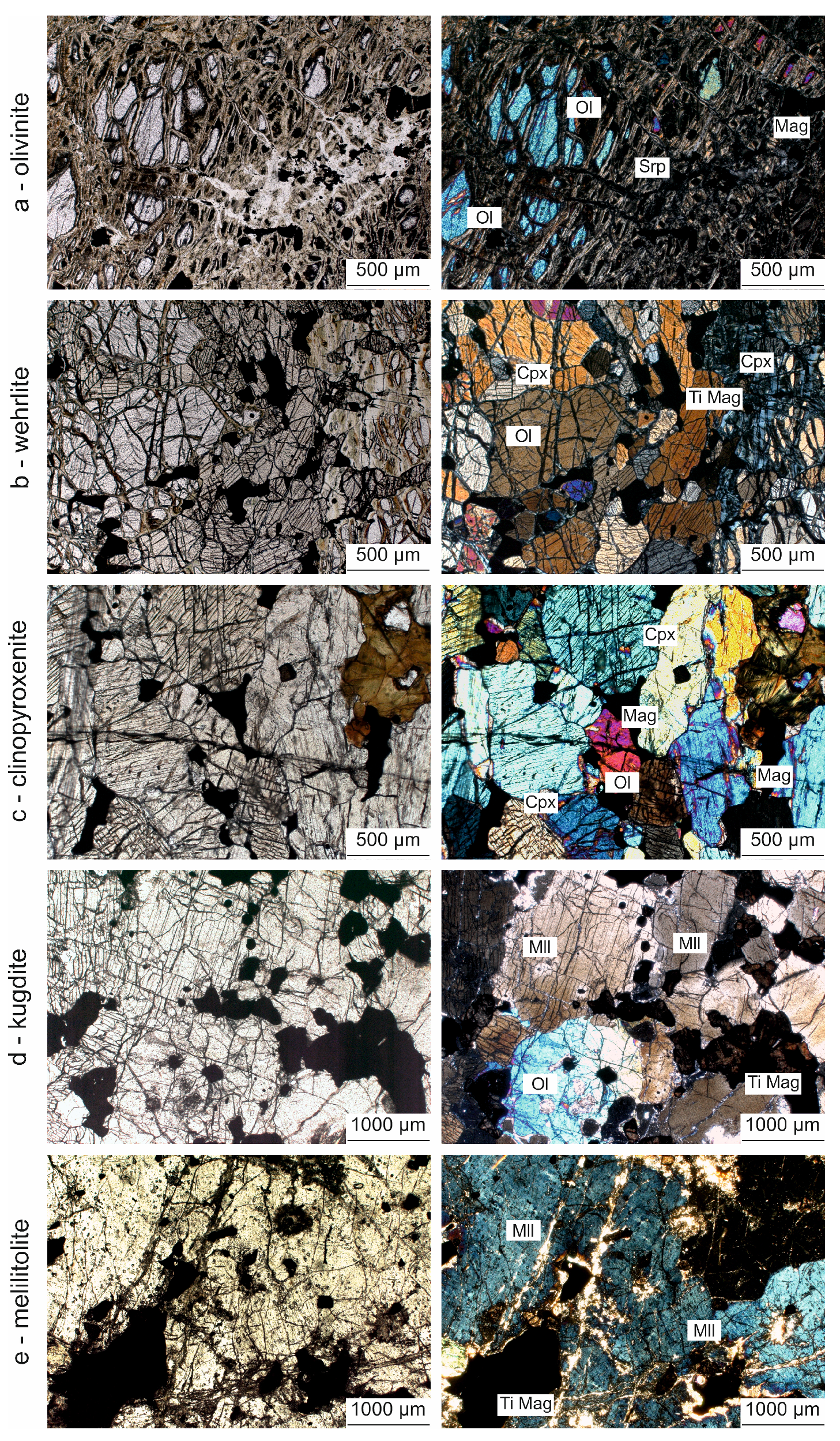
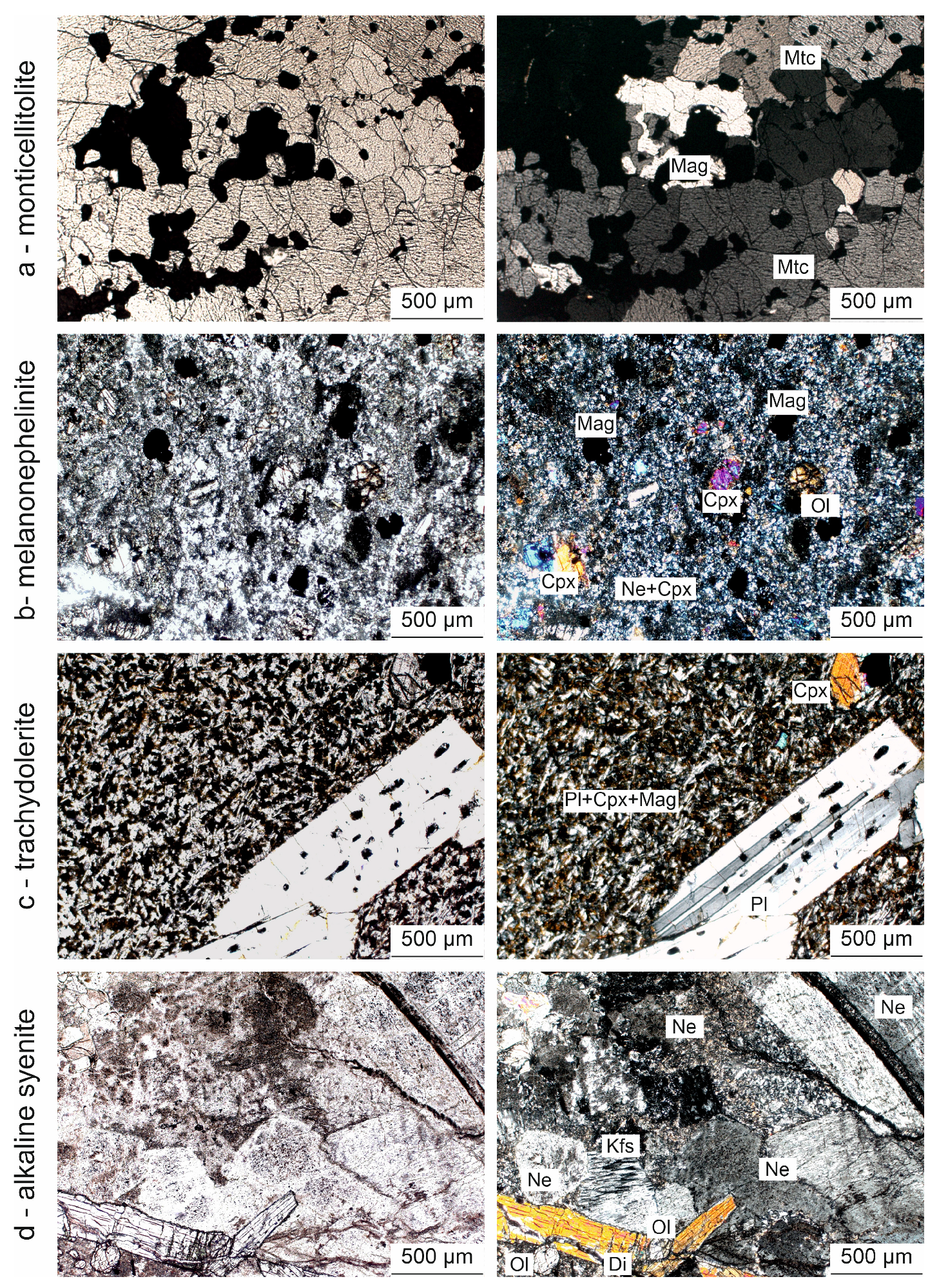
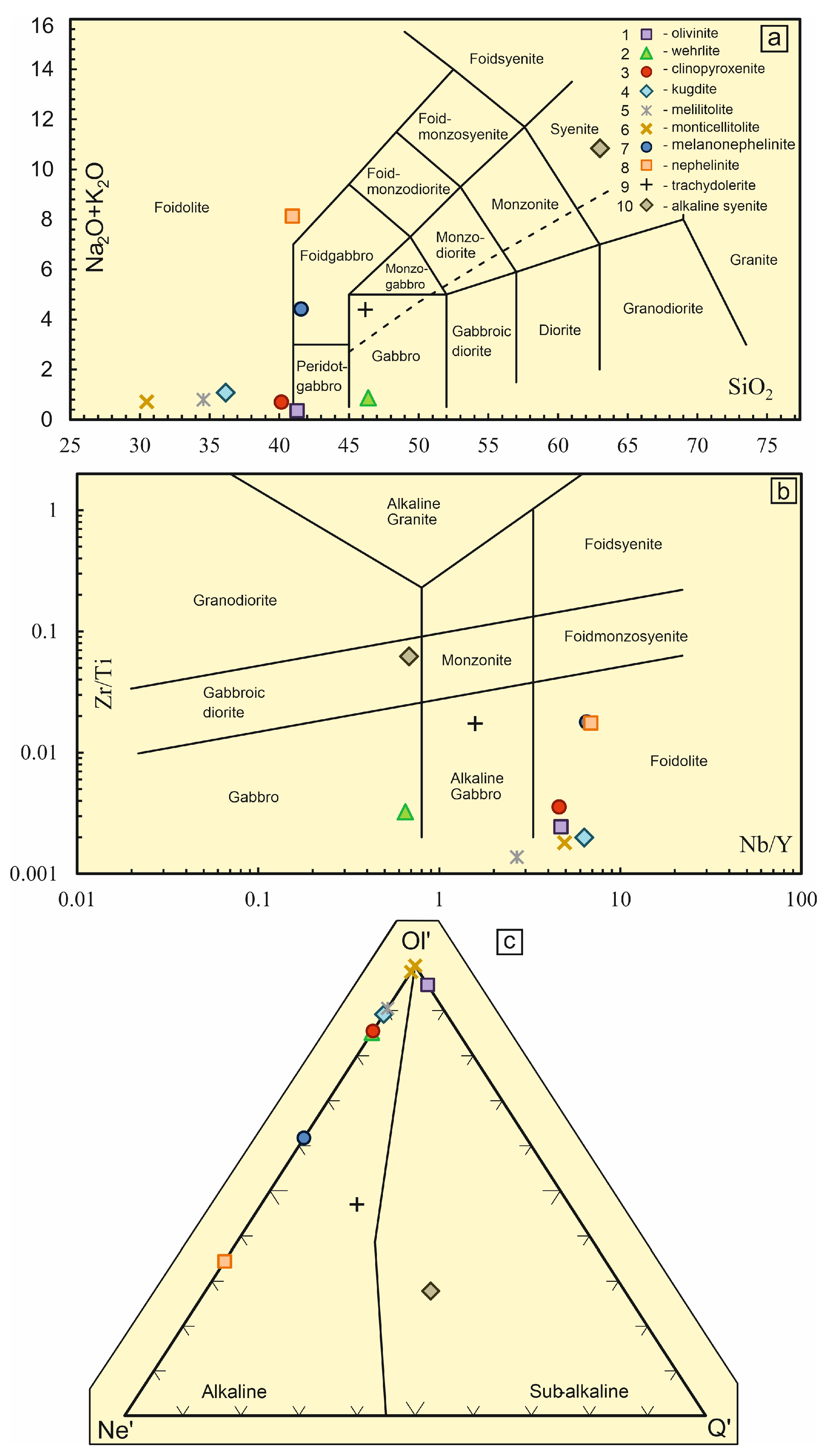
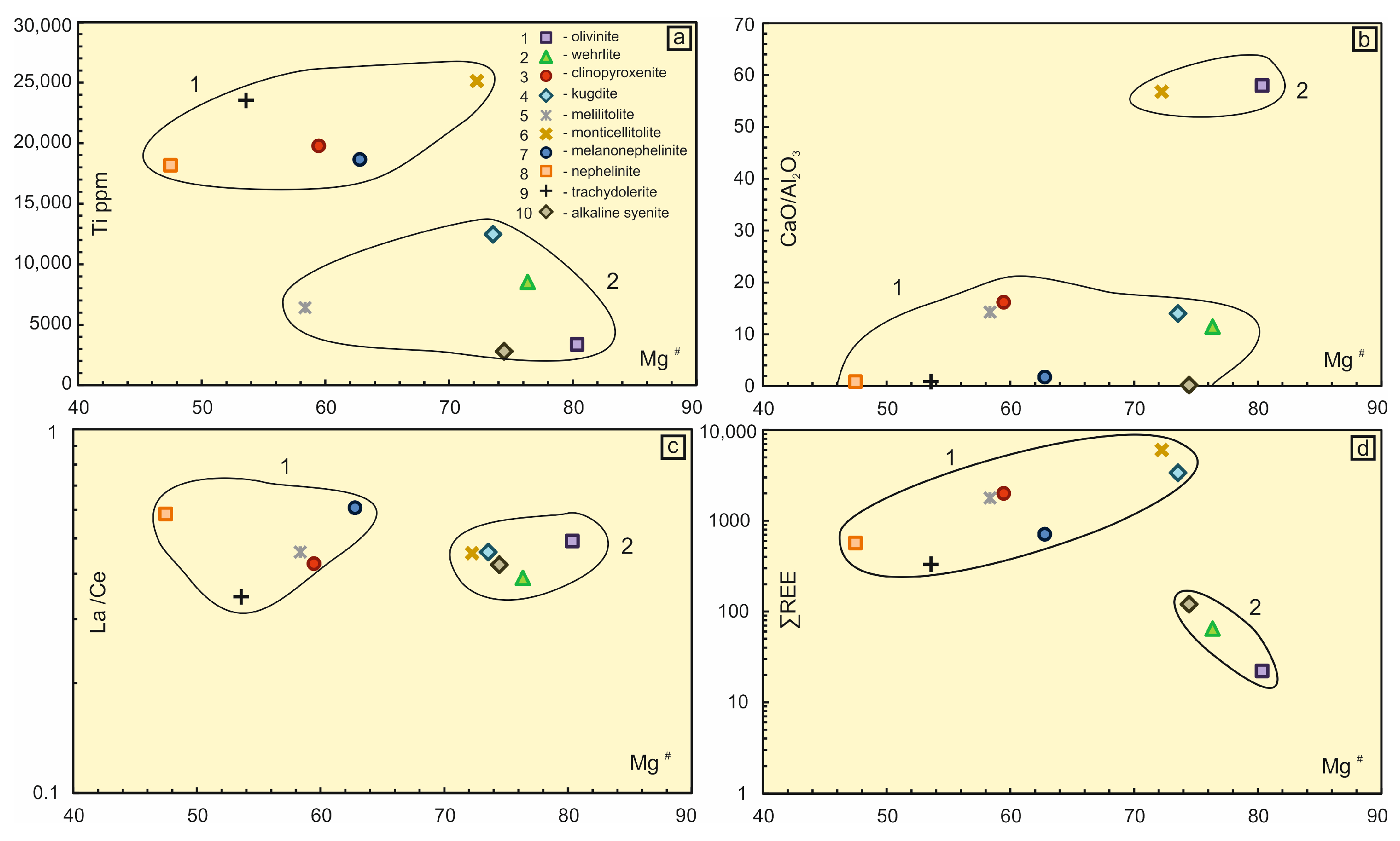


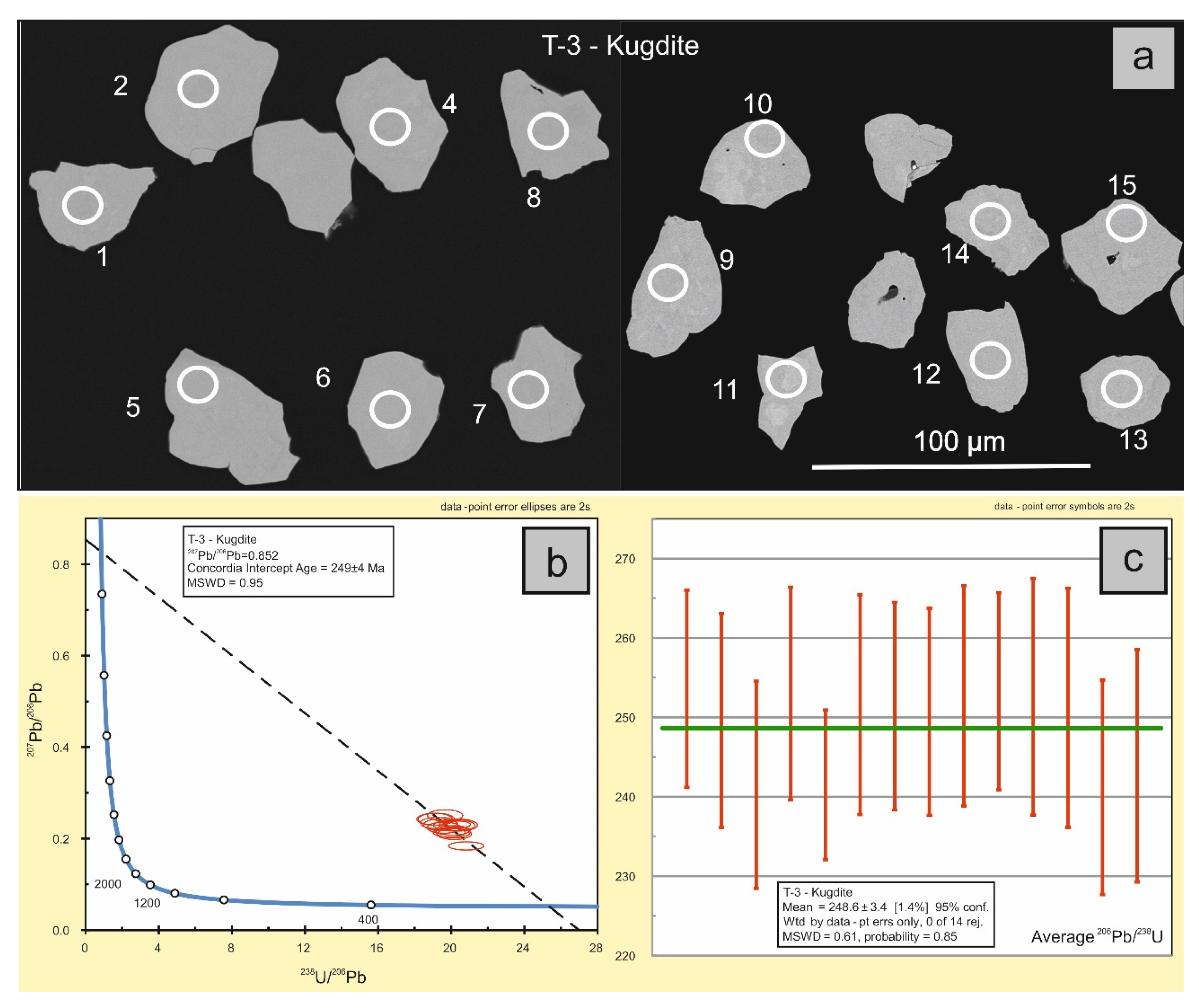
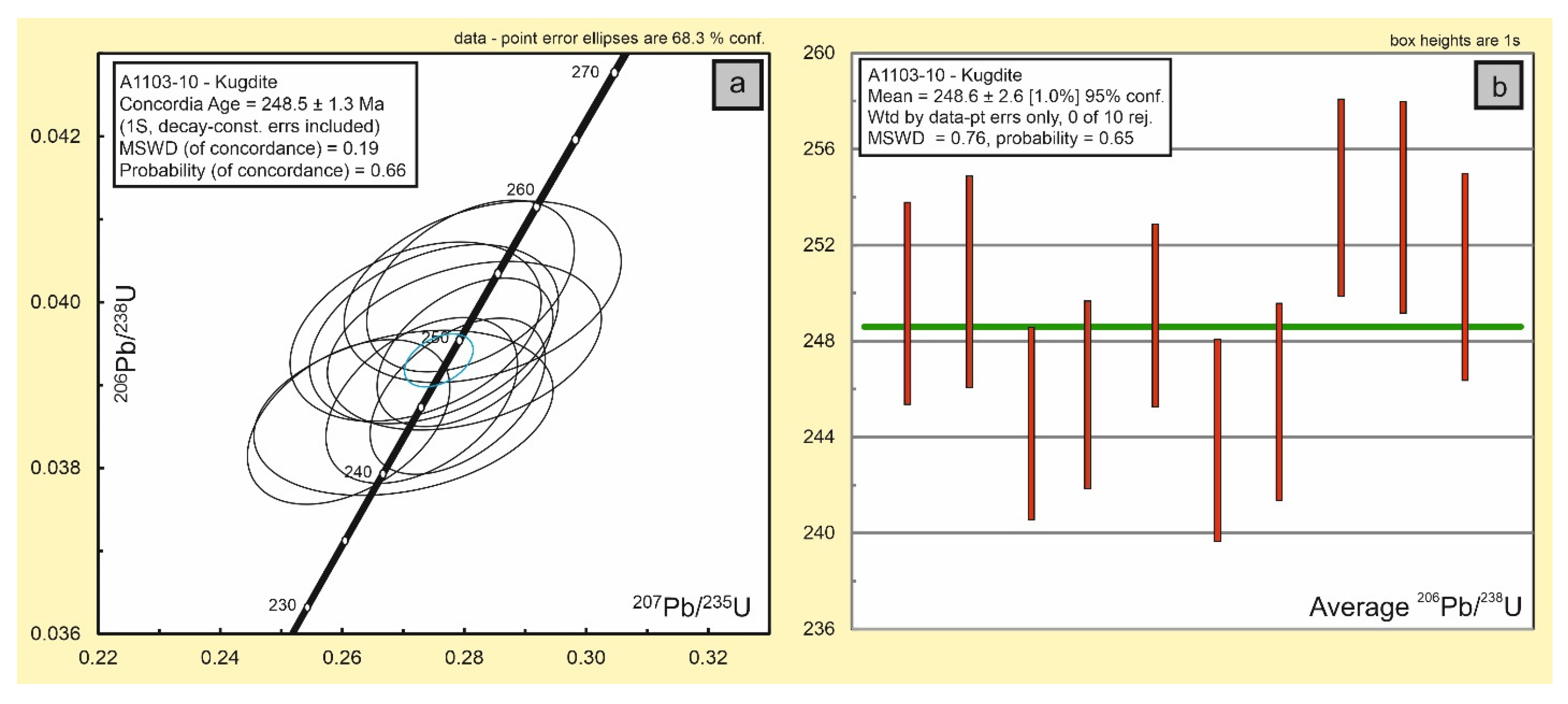

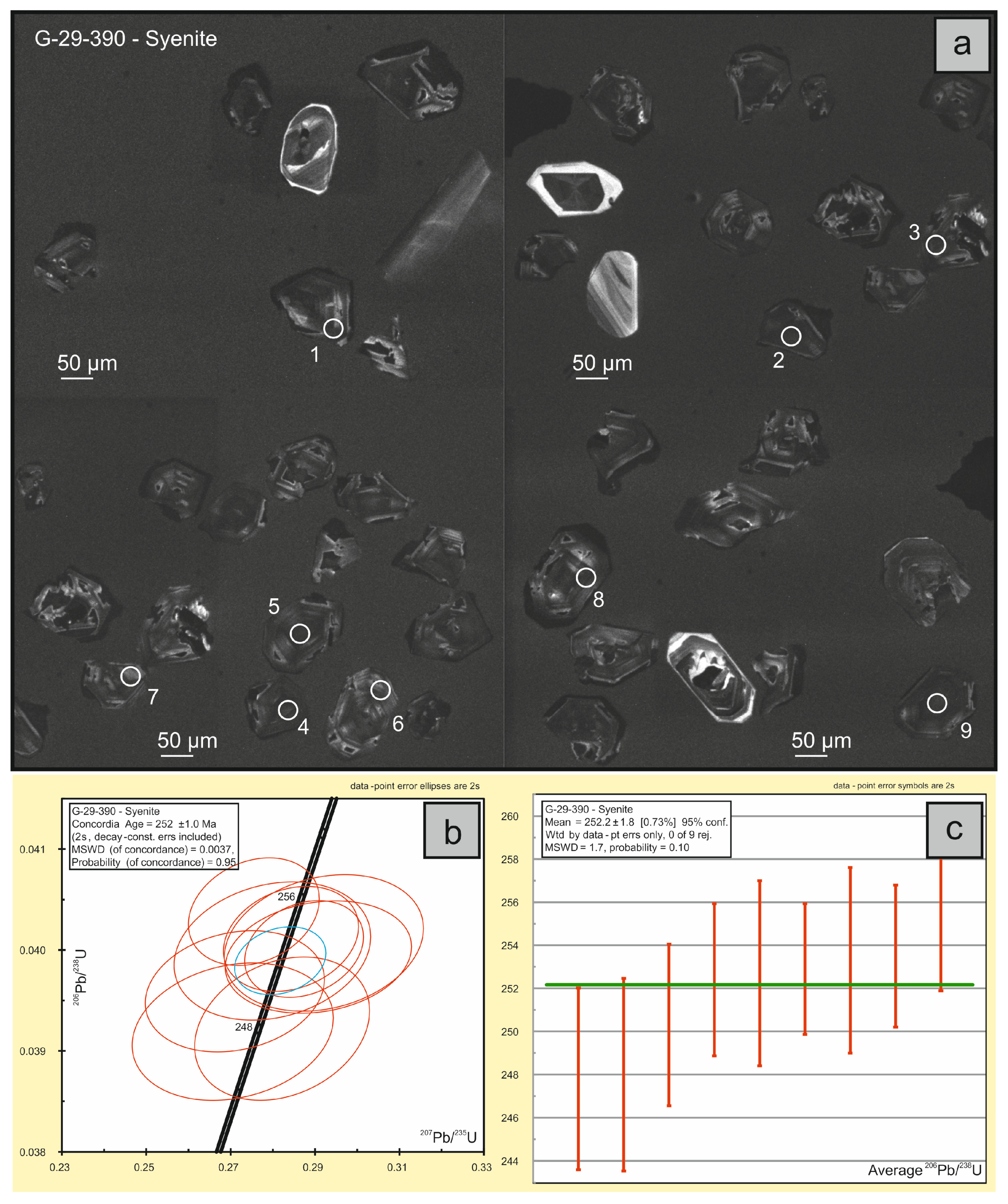

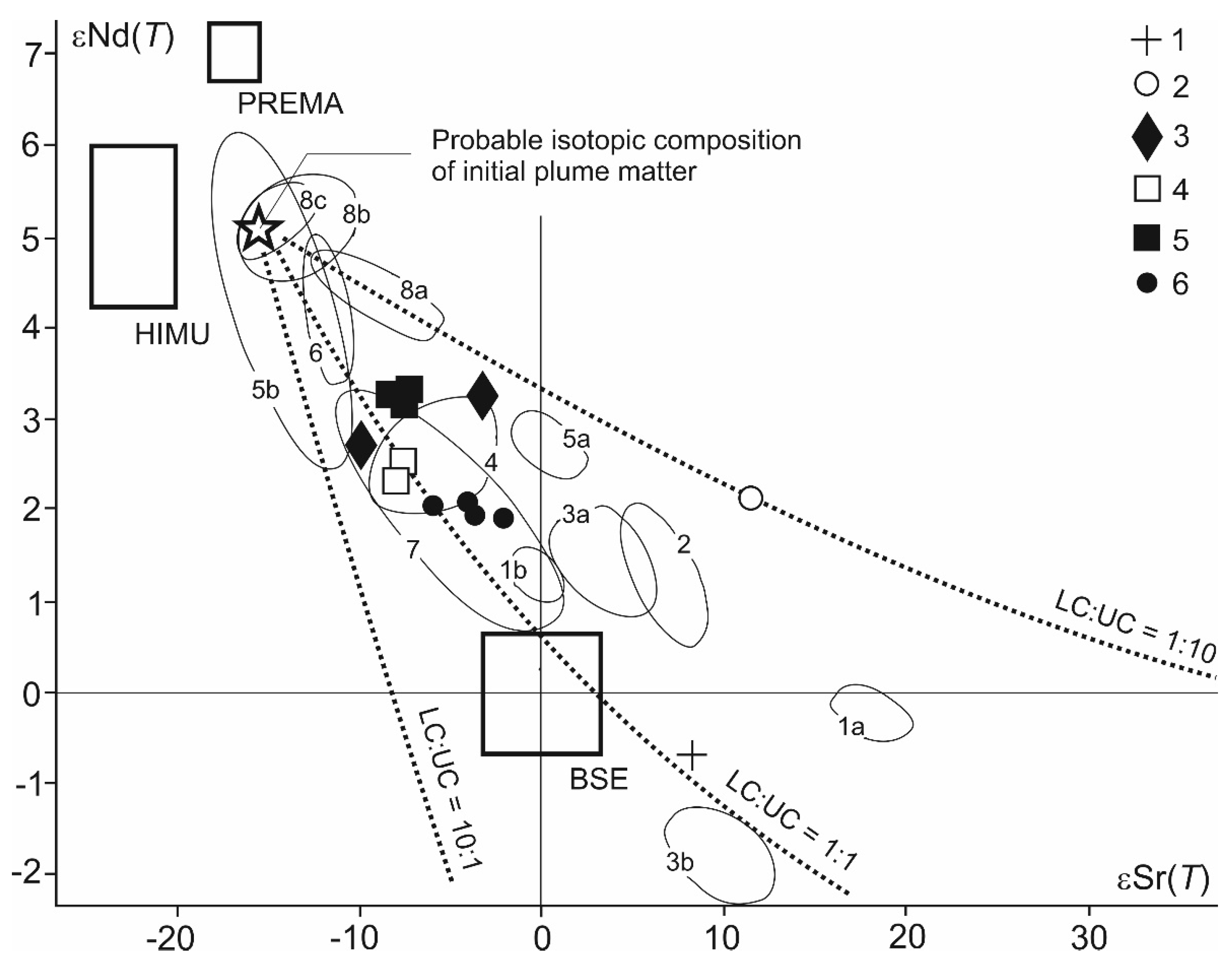
| Suite/Complex | Rock Type (Mineral/Whole Rock) | Dating Method | Age, Ma | Reference |
|---|---|---|---|---|
| Maimecha Suite | Meimechite (Biotite) | 40Ar/39Ar | 246 ± 1.2 | [42] |
| Delkanskaya Suite | Meimechite (Zircon) | 238U/206Pb | 251.1 ± 0.3 | [1] |
| Arygdjan Suite | Meimechite (Perovskite) | 238U/206Pb | 251.7 ± 0.4 | [1] |
| Arygdjan Suite (low part) | Melanonephelinite (Whole rock) | 40Ar/39Ar | 253 ± 2.6 | [34] |
| Guli Complex | Carbonatite (Baddeleyite) | 238U/206Pb | 250.2 ± 0.3 | [1] |
| Guli Complex | Bulk (Whole rock) | 238U/206Pb | 250 ± 9.0 | [35] |
| Delkanskaya Suite | Tuff (Whole rock) | 238U/206Pb | 251.9–251.5 | [17] |
| Arygdjan Suite | Lava (Whole rock) | 238U/206Pb | 252.3–252.2 | [17] |
| Guli Complex | Carbonatite (Thorianite) | Th/Pb | 250.1 ± 2.9 | [36] |
| Guli Complex | Carbonatite (Baddeleyite) | 238U/206Pb | 250.8 ± 1.2 | [36] |
| Kresty Complex | Olivinite, Wehrlite, Clinopyroxenite (Whole rock) | 147Sm/144Nd | 251 ± 20 | [13] |
| Kresty Complex | Alkaline Syenite (Zircon) | 238U/206Pb | 249 ± 1.0 | [This study] |
| Kresty Complex | Alkaline Syenite (Zircon) | 238U/206Pb | 252 ± 1.0 | [This study] |
| Kresty Complex | Kugdite (Perovskite) | 207Pb/206Pb | 249 ± 4.0 | [This study] |
Disclaimer/Publisher’s Note: The statements, opinions and data contained in all publications are solely those of the individual author(s) and contributor(s) and not of MDPI and/or the editor(s). MDPI and/or the editor(s) disclaim responsibility for any injury to people or property resulting from any ideas, methods, instructions or products referred to in the content. |
© 2024 by the authors. Licensee MDPI, Basel, Switzerland. This article is an open access article distributed under the terms and conditions of the Creative Commons Attribution (CC BY) license (https://creativecommons.org/licenses/by/4.0/).
Share and Cite
Sazonov, A.M.; Gertner, I.F.; Mustafaev, A.A.; Krasnova, T.S.; Kolmakov, Y.V.; Kingsbury, C.G.; Gogoleva, V.A. Early Triassic Episode of the Kresty Volcano–Plutonic Complex Formation in the Maymecha-Kotuy Alkaline Province, Polar Siberia: Geochemistry, Petrology and Uranium–Lead Geochronology. Minerals 2024, 14, 83. https://doi.org/10.3390/min14010083
Sazonov AM, Gertner IF, Mustafaev AA, Krasnova TS, Kolmakov YV, Kingsbury CG, Gogoleva VA. Early Triassic Episode of the Kresty Volcano–Plutonic Complex Formation in the Maymecha-Kotuy Alkaline Province, Polar Siberia: Geochemistry, Petrology and Uranium–Lead Geochronology. Minerals. 2024; 14(1):83. https://doi.org/10.3390/min14010083
Chicago/Turabian StyleSazonov, Anatoly M., Igor F. Gertner, Agababa A. Mustafaev, Tatyana S. Krasnova, Yurii V. Kolmakov, Cole G. Kingsbury, and Vera A. Gogoleva. 2024. "Early Triassic Episode of the Kresty Volcano–Plutonic Complex Formation in the Maymecha-Kotuy Alkaline Province, Polar Siberia: Geochemistry, Petrology and Uranium–Lead Geochronology" Minerals 14, no. 1: 83. https://doi.org/10.3390/min14010083
APA StyleSazonov, A. M., Gertner, I. F., Mustafaev, A. A., Krasnova, T. S., Kolmakov, Y. V., Kingsbury, C. G., & Gogoleva, V. A. (2024). Early Triassic Episode of the Kresty Volcano–Plutonic Complex Formation in the Maymecha-Kotuy Alkaline Province, Polar Siberia: Geochemistry, Petrology and Uranium–Lead Geochronology. Minerals, 14(1), 83. https://doi.org/10.3390/min14010083






